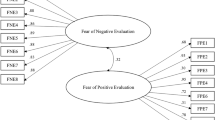Abstract
The present study investigated the way in which feared outcomes are organized in long-term memory in children and adolescents. A list of items relating to threatening outcomes, originally generated by children, was given to an additional 560 children (aged 6 to 16) and rated for the degree to which they worried about each. Factor analysis revealed two interpretable factors of feared outcomes. The first factor centered on concerns about physical harm while the second factor centered on social consequences that children and adolescents worry about. The two factors were consistent across gender, age, and clinical status. A scale involving the maximally discriminating items showed good internal consistency and test-retest reliability.
Similar content being viewed by others
References
Arrindel, W. A., Emmelkamp, P. M. G., & van der Ende, J. (1984). Phobic dimensions: Reliability and generalizability across samples, gender, and nations.Advances in Behavior Research and Therapy, 6, 207–254.
Bamber, J. H. (1974). The fears of adolescents.Journal of Genetic Psychology, 125, 127–140.
Bates, H. D. (1971). Factorial structure and MMPI correlates of a fear survey schedule in a clinical population.Behaviour Research and Therapy, 9, 355–360.
Beck, A. T., & Clark, D. A. (1988). Anxiety and depression: An information processing perspective.Anxiety Research, 1, 23–36.
Cattell, R. B. (1966). The meaning and strategic use of factor analysis. In R. B. Cattell (Ed.),Handbook of multivariate experimental psychology. Chicago: Rand McNally.
Derogatis, L. R. (1977).SCL-90. Administration, scoring, and procedures manual for the revised version and other instruments of the Psychopathology Rating Scale series. Boston: John Hopkins.
Endler, N. S., Hunt, J. M., & Rosenstein, A. (1962). An S-R inventory of anxiousness.Psychological Monographs, 76, 1–33.
Endler, N. S., & Okada, M. (1975). A multidimensional measure of trait anxiety: The S-R inventory of general trait anxiousness.Journal of Consulting and Clinical Psychology, 43, 319–329.
Geer, J. H. (1965). The development of a scale to measure fear.Behaviour Research and Therapy, 3, 45–53.
Harter, S., & Whitesell, N. R. (1989). Developmental changes in children's understanding of single, multiple and blended emotion concepts. In C. Saarni and P. L. Harris (Eds.).Children's understanding of emotion (pp. 81–116). Cambridge, England: Cambridge University Press.
Hope, D. A., Rapee, R. M., Heimberg, R. G., & Dombeck, M. J. (1990). Representations of the self in social phobia: Vulnerability to social threat.Cognitive Therapy and Research, 14, 177–189.
Katzenmeyer, W. G., & Stenner, A. J. (1977). Estimation of the invariance of factor structure across sex and race with implications for hypothesis testing.Educational and Psychological Measurement, 17, 111–119.
King, N. J., Ollier, K., Iacuone, R., Schuster, S., Bays, K., Gullone, E., & Ollendick, T. H. (1989). Fears of children and adolescents: A cross-sectional Australian study using the Revised-Fear Survey Schedule for Children.Journal of Child Psychology and Psychiatry, 30, 775–784.
Kovacs, M., & Beck, A. T. (1977). An empirical clinical approach towards a definition of childhood depression. In J. G. Schulterbrandt and A. Raskin (Eds.),Depression in children: Diagnosis, treatment, and conceptual models (pp. 1–25). New York: Raven Press.
Lang, P. J. (1979). A bio-informational theory of emotional imagery.Psychophysiology, 16, 495–511.
Lovibond, P. F., & Rapee, R. M. (1993). The representation of feared outcomes.Behaviour Research and Therapy, 31, 595–608.
McCathie, H., & Spence, S. H. (1991). What is the revised fear survey schedule for children measuring?Behaviour Research and Therapy, 29, 495–502.
McNally, R. J. (1990). Psychological approaches to panic disorder: A review.Psychological Bulletin, 108, 403–419.
Miller, L. C., Barrett, C. L., Hampe, E., & Noble, H. (1972). Factor structure of childhood fears.Journal of Consulting and Clinical Psychology, 39, 264–268.
Ollendick, T. H. (1983). Reliability and validity of the revised fear survey schedule for children (FSSC-R).Behaviour Research and Therapy, 21, 685–692.
Ollendick, T. H., Matson, J. L., & Helsel, W. J. (1985). Fears in children and adolescents: Normative data.Behaviour Research and Therapy, 23, 465–467.
Rapee, R. M. (1991). Generalized anxiety disorder: A review of clinical features and theoretical concepts.Clinical Psychology Review, 11, 419–440.
Reynolds, C. R., & Richmond, B. O. (1978). What I think and feel: A revised measure of children's manifest anxiety.Journal of Abnormal Child Psychology, 6, 271–280.
Simon, A., & Ward, L. O. (1974). Variables influencing the sources, frequency and intensity of worry in secondary school pupils.British Journal of Social and Clinical Psychology, 13 391–396.
Simon, A., & Ward, L. O. (1982). Sex-related patterns of worry in secondary school pupils.British Journal of Clinical Psychology, 21, 63–64.
Spielberger, C. D. (1970).Preliminary manual for State-Trait Anxiety Inventory for children. Palo Alto, CA: Consulting Psychologists Press.
Stattin, H., Magnusson, D., Olah, A., Kassin, H., & Reddy, N. Y. (1991). Perception of threatening consequences of anxiety-provoking situations.Anxiety Research, 4, 141–166.
Tabachnick, B. G., & Fidell, L. (1983).Using multivariate statistics. New York: Harper and Row.
Author information
Authors and Affiliations
Additional information
The authors would like to thank Paula Barrett, Mark Dadds and the people from the Child Anxiety Project for access to anxious children.
Rights and permissions
About this article
Cite this article
Campbell, M.A., Rapee, R.M. The nature of feared outcome representations in children. J Abnorm Child Psychol 22, 99–111 (1994). https://doi.org/10.1007/BF02169258
Revised:
Issue Date:
DOI: https://doi.org/10.1007/BF02169258




